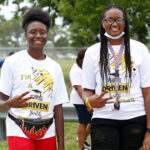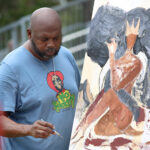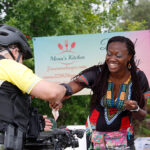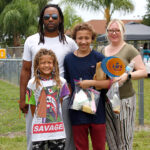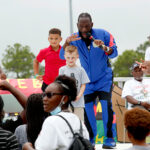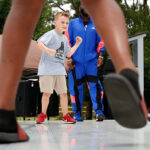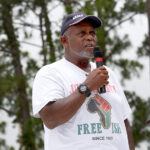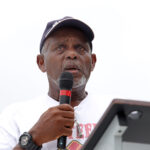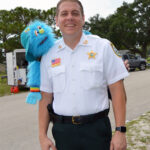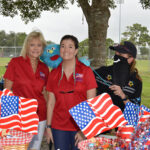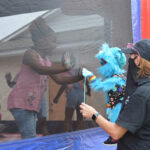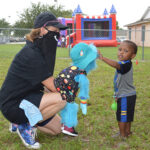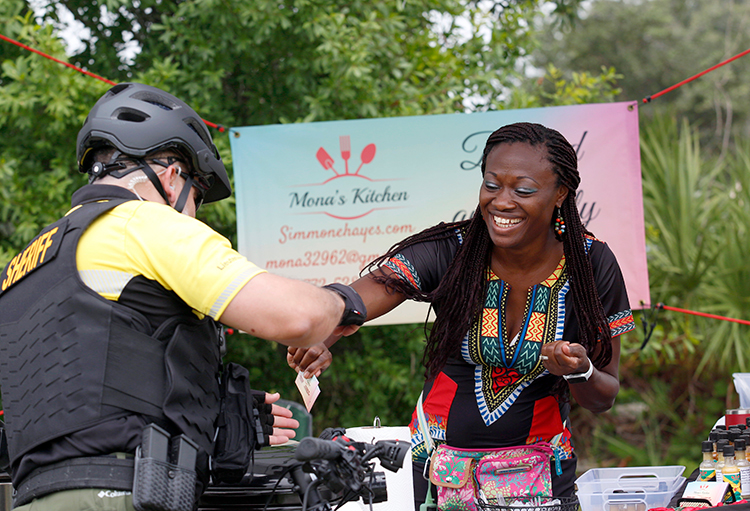
The recent Juneteenth Celebration at the Victor Hart Sr. Community Enhancement Complex brought the community together to commemorate June 19, 1865, the day enslaved people in Texas were informed that they were free. The date, sometimes known as Black Independence Day, was two and a half years after the signing of the Emancipation Proclamation and was nearly nine decades after the signing of the Declaration of Independence.
The celebratory day featured performances by members of various local nonprofit organizations, such as Youth Guidance, Boys and Girls Clubs, Big Brothers Big Sisters and Gifford Youth Orchestra. There were also speeches by local notables, great food, vendors, football games and children’s activities at the Moonshot Moment Rocket bus, before a lightning storm brought activities to an end.
At the nearby Gifford Youth Achievement Center, Faz Zaidi, a 16-year-old student at Holy Trinity in Melbourne, had teamed up with Treasure Coast Community Health to administer COVID vaccines and enlisted the support of local physicians Dr. Robert Henley and Dr. Aisha Thomas-St. Cyr to answer questions and alleviate concerns.
Zaidi said he had started a podcast in March 2020 featuring pandemic-related issues, and learned about the Juneteenth Celebration through an interview with Freddie Woolfork, director of public relations and facilities management at GYAC.
“I thought that would be a really good way to get people vaccinated,” said Zaidi, whose parents, Dr. Saatia Jaffry and Dr. Farhan Zaidi, are area physicians.
“It’s really important, because we’re seeing that the COVID cases and deaths are centered among those who are not vaccinated,” said Zaidi, adding that vaccines also offer vital protection against the highly infectious and deadly Delta variant.
Earlier in the day, the value of a good education was showcased with the unveiling of a historic marker at Hosie Shumann Park, the site of the original Gifford School.
“This was a labor of love for Anthony “Tony” Brown, president of the NAACP,” said Jonnie Mae Perry, CEO of the Gifford Community Cultural and Resource Center.
The original school, built on land donated in 1901 by William Edward Geoffrey, initially served first through sixth grades and was operated by parents and church members.
“If you wanted to go past sixth grade, then you had to go to Brevard or Fort Pierce,” said Perry, explaining that because of segregation, Black children were not allowed to attend school in Vero Beach.
She said that one man, John Broxton, wanted an education for his and other Black children, so he began driving them to school in Fort Pierce; eventually purchasing a bus to transport them. His daughter, Bernice Broxton Johnson, would later become a teacher at Gifford High School. In 1937, the school became all inclusive, serving first through 12th grades, and was known as Gifford High School. In 1952 a new Gifford High School was built on 45th Street, home today to Gifford Middle School.
The marker was unveiled by Anna Reagans Lane, 100 years old and the school’s oldest known living graduate, and Joe Idlette Jr., a graduate of the school who, despite threats from the Ku Klux Klan, courageously led the fight for local schools to be integrated in 1969.
He also served on the School Board for 20 years. Other notable graduates at the unveiling included Dr. A. Ronald Hudson, a co-founder of Gifford Youth Achievement Center, and Godfrey Gibson, president of the Gifford High School Alumni and Friends Association.
Perry said that the church was another important foundation of the Black community throughout slavery and beyond, noting: “During the horrific days of slavery, it provided relief and nourishment for the soul with its promise of a better life after death. The church gave the slave dignity and assured him he was equal in the eyes of God. No matter how difficult his unbearable suffering was, it was religious faith that sustained the slaves and enabled them to endure such bondage.”
Photos by Kaila Jones


